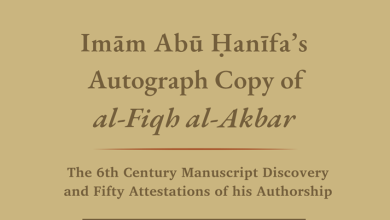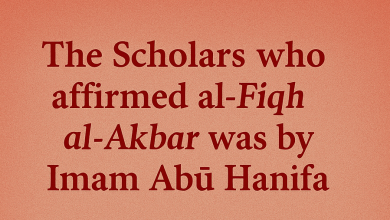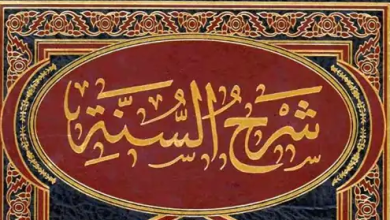Doctrinal Transmission in the Ḥanafī School: Manuscript Testimonies Attributing al-ʿAqīda al-Ṭaḥāwiyya to Imām Abū Ḥanīfa and His Two Companions
Unveiling the True Origins of al-ʿAqīda al-Ṭaḥāwiyya
For over a millenimum, al-ʿAqīda al-Ṭaḥāwiyya has occupied a central position within Sunnī theological literature as a concise articulation of orthodox Islamic belief. Studied across masjids, religious seminaries, and academic institutions worldwide, this creedal statement has long been regarded as a definitive expression of the doctrines upheld by the People of the Sunna and the Community [Ahl al-Sunna wa-l-Jamāʿa].
Despite its widespread acceptance and canonical status, a fundamental question concerning the text’s authorial attribution has remained inadequately addressed within contemporary scholarship: did Imām Abū Jaʿfar al-Ṭaḥāwī (d. 321 AH) compose this creed as an independent theological work, or did he function as a transmitter of the established creedal teachings of the early Ḥanafī authorities—namely Imām Abū Ḥanīfa al-Nuʿmān ibn Thābit (d. 150 AH) and his two principal disciples, Abū Yūsuf Yaʿqūb ibn Ibrāhīm al-Anṣārī (d. 182 AH) and Muḥammad ibn al-Ḥasan al-Shaybānī (d. 189 AH)?
This study emerged from the necessity to resolve this question through rigorous manuscript analysis and examination of classical testimonies.
Methodological Approach
The present research undertook a systematic collation of manuscript witnesses preserved in major institutional repositories including al-Azhar University, the Süleymaniye Library in Istanbul, the Berlin State Library, Chester Beatty Library in Dublin, and the Bibliothèque nationale de France. Through careful examination of colophons, marginal annotations, and introductory formulae across these manuscripts, a consistent pattern of attribution emerged that had been largely overlooked in modern editions of the text.
The Text as Transmission Rather Than Composition
Multiple early manuscript witnesses explicitly characterise al-ʿAqīda al-Ṭaḥāwiyya as a faithful transmission [riwāya] of the doctrinal positions held by Imām Abū Ḥanīfa and his companions. A particularly significant textual witness, preserved in the Beyazıt Collection (MS B7955, fol. 45a), records Imam al-Ṭaḥāwī’s own methodological declaration in which he stated: “I have examined the school [madhhab] of the greatest Imam [al-Imām al-A’ẓam] Abū Ḥanīfa al-Nu’mān ibn Thābit al-Kūfī, may Allah have mercy upon him, and Abū Yūsuf Ya’qūb ibn Ibrāhīm al-Anṣārī, and Abū ‘Abd Allāh Muḥammad ibn al-Ḥasan al-Shaybānī, may Allah be pleased with them all, and what they believe regarding the principles of religion and with which they practise the religion of the Lord of the Worlds, and I found them saying concerning the oneness of Allah…”’
Such terminology indicates that al-Ṭaḥāwī understood his role as that of a narrator documenting authenticated doctrine rather than an independent author formulating novel theological positions.
Classical Scholarly Attestations
The manuscript evidence finds corroboration in explicit testimonies from classical Ḥanafī authorities spanning several centuries. Imām Abū al-Muʿīn al-Nasafī (d. 508 AH), writing within two centuries of al-Ṭaḥāwī’s death, quoted Imam al-Ṭaḥāwī saying in an early manuscript of al-ʿAqīda al-Ṭaḥāwiyya:
‘The school of the jurists of the community has been authenticated [ṣaḥḥa] to me: Abū Ḥanīfa al-Nu’mān ibn Thābit al-Kūfī, and Abū Yūsuf Ya’qūb ibn Ibrāhīm al-Anṣārī, and Abū ‘Abd Allāh Muḥammad ibn al-Ḥasan al-Shaybānī.’ Then he proceeded to explain their statements.”
Similarly, Imām Mankubars al-Nāṣirī (d. 652 AH) in his commentary al-Nūr al-Lāmiʿ wa-l-Burhān al-Sāṭiʿ explicitly stated that the work constituted an exposition of the creed which Imam al-Ṭaḥāwī transmitted from Imam Abū Ḥanīfa and his two companions by saying: “And this book contains an explanation of the creed of the People of Truth [Ahl al-Ḥaqq] which Imam Abū Jaʿfar al-Ṭaḥāwī transmitted from Abū Ḥanīfa al-Nuʿmān ibn Thābit, Abū Yūsuf Yaʿqūb ibn Ibrāhīm, and Abū ʿAbdullāh Muḥammad ibn al-Ḥasan al-Shaybānī, and what they believe of the foundations of religion and what they profess to the Lord of the Worlds.”
Imām Jamāl al-Dīn al-Qūnawī (d. 777 AH) was quoted as saying in his as al-Qalā’id fī Sharḥ al-‘Aqā’id:
“The jurist Abū Ja’far al-Ṭaḥāwī -may the mercy of Allah the Exalted be upon him- said:
Imām Abū Ḥanīfa -may Allah be pleased with him- said, and with him said his two companions Abū Yūsuf and Muḥammad -may Allah the Exalted have mercy upon them both:
We say concerning the divine unity [tawḥīd] of Allah, believing, by the gracious aid [tawfīq] of Allah the Exalted.”
And Shaykh Ḥasan Kāfī al-Āqḥiṣārī (d. 1025 AH) said in his commentary on al-‘Aqīda al-Ṭahāwiyya known as Nūr al-Yaqīn fī Uṣūl al-Dīn:
“Among those who established this truth with proper establishment – standing in that position of leadership – was the Imam Abū Ja’far Aḥmad ibn Muḥammad ibn Salāma al-Azdī al-Ṭaḥāwī, may the mercy of his Self-Sufficient Lord be upon him. He was born in the year two hundred and thirty-nine after the second century, and he passed away in the year three hundred and twenty-one. He conveyed (akhbara) what the jurists of the pure Ḥanafī school and the leading scholars among the inheritors of the Prophetic legacy of the Chosen One believed, such as the Greatest Imam Abū Ḥanīfa Nu’mān ibn Thābit al-Kūfī, and his two companions Abū Yūsuf Ya’qūb ibn Ibrāhīm al-Anṣārī and Muḥammad ibn al-Ḥasan al-Shaybānī – may the mercy of their Self-Sufficient Lord be upon them – regarding what they believed of the principles of religion, and what they held as their faith before the Lord of the Worlds. He compiled on this subject a famous book known as The Creed of al-Ṭaḥāwī (‘Aqā’id al-Ṭaḥāwī), in which he clarified the difficult matters and the obscurities, and distinguished the sweet from the sour. It is a book the likes of which the eye of time has never beheld, in the elegance of its expressions and the subtlety of its meanings.”
Dr. Sā’id ibn Muḥammad Yaḥyá Bakdāsh (the son in law of Shaykh Muḥammad ʿAwwāma) has been quoted providing these points over some pages:
“And amongst the most graceful, beneficial, magnificent, and innovative of what has been authored in it is the book: al-Fiqh al-Akbar (The Greater Jurisprudence), by the Greatest Imam, the Sultan of Scholars, the famous Successor (Tabi’i): Abu Hanifa al-Nu’mān ibn Thābit al-Kūfī (d. 150 AH), without any doubt as to the correctness of its attribution to him, as the clarification of that will come.
And it is a great concise book, elegant and marvellous, full, abundant, and beneficial. Rather, it is a graceful treatise, comprehensive and restrictive in its subject, from amongst the earliest works of the best of generations, which is easy to memorise, and it is not permissible for the legally responsible Muslim to be ignorant of its pure content and sufficient substance.
And it represents the authoritative source regarding the creed of Imam Abu Hanifa, and the creed of his companions, and those who followed them from amongst their emulators from the noble Ḥanafīs, for they are Ḥanafī in creed and jurisprudence.
And he named it: al-Fiqh al-Akbar (The Greater Jurisprudence), because the nobility of knowledge and its greatness is according to the nobility of what is known, and there is nothing known greater and more magnificent than the Essence of Allah the Exalted, His Names, and His Attributes.
A book that resembles it and is similar to it in its content and formulation to a great extent, in form and meaning, in its high scholarly standing, its lofty elevated status, its acceptance and approval as an authoritative creed amongst the noble Ḥanafīs and others, its widespread dissemination, circulation, and teaching in schools of knowledge in all regions, in its concise size and worth, and in most of its issues with subtle additions, with very similar wording: the book al-ʿAqīda al-Tahawiyya (The Tahawiyya Creed).
Imam al-Ṭaḥāwī (229 [or 239] – 321 AH) narrated it with his chain of transmission from Imam Abu Hanifa, and attributed it to him from his speech, as it appears in its introduction in many of its manuscript copies:
( هذا ما رواه الإمام الطحاوي في ذكر بيان اعتقاد أهل السُّنَّةِ والجماعة … قال الإمام أبو حنيفة، وبه قال صاحباه…. إلخ). اهـ
(This is what Imam al-Ṭaḥāwī narrated regarding the statement of the creed of Ahlus Sunna wa’l Jamā’ah… Imam Abu Hanifa said, and his two companions agreed with him… etc.). End.
Based on this, the content of al-ʿAqīda al-Tahawiyya is from the speech of Imam Abu Hanifa, narrated by Imam al-Ṭaḥāwī from him, and is not from the speech of al-Ṭaḥāwī, just like Imam al-Bukhārī’s narration in his Ṣaḥīḥ of the sayings of our Master the Messenger of Allah, peace and blessings be upon him.
Accordingly, it must be said that the creed of the noble Ḥanafīs is what Imam Abu Hanifa himself recorded in al-Fiqh al-Akbar, which his son Imam Ḥammād narrated from him, and what al-ʿAqīda al-Tahawiyya contains from the speech of Abu Hanifa, with which Abū Yūsuf and Muḥammad agreed, which Imam al-Ṭaḥāwī narrated from them.
And it is noted here that the content of these two books, and what they contain of fundamental principles and foundations, and statements and opinions regarding issues of creed and divine unity [tawḥīd], are the essence of what the juristic reasoning [ijtihād] of Imam Abu Hanifa reached in the texts of the Book and the Sunna, in this precise subject and this important and intricate science—the science of divine unity [tawḥīd]. And it is the distilled knowledge of a long lifetime of his Imamate, may Allah be pleased with him, which surpassed the bridge, and which both near and far testified to.”
Conclusion
The convergence of manuscript testimony, classical scholarly attestation, and transmissional analysis substantiates that al-ʿAqīda al-Ṭaḥāwiyya represents an authentic preservation of the creedal teachings of Imām Abū Ḥanīfa and his two principal disciples, transmitted through authenticated chains by Imām Abū Jaʿfar al-Ṭaḥāwī. This recognition fundamentally reorients the text’s scholarly status from that of a fourth-century creedal composition to that of a second-century transmitted document, with significant implications for our understanding of early Islamic theological development.
The full study, complete with manuscript documentation, classical testimonies, and detailed analysis, is available for consultation and download below.
Table of Contents
A Short Biography of Imām Abū Ja’far al-Ṭaḥāwī 7
Imām al-Taḥāwī’s chains of transmission back to Imām Abū Hanīfa. 10
The Authoritative Ḥanafī Creedal Texts as the words of Imam Abu Hanifa. 11
Imam Tāj ud-Dīn as-Subkī (d. 771 AH) on the acceptance of al-ʿAqīda al-Ṭaḥāwiyya. 25
Dr. Sāʿid Bakdāsh on al-Fiqh al-Akbar of Imām Abū Ḥanīfa (riwāya of his son Ḥammād) 27
Dr. Sāʿid Bakdāsh on al-ʿAqīda al-Tahawiyya. 29
The Attention of Ḥanafī Scholars to al-ʿAqīda al-Tahawiyya: 34
Imām Ibn al-Shiḥna (d. 890 AH) on Ibn Abī al-ʿIzz. 35
Manuscript copies of al-Fiqh al-Akbar. 38
Manuscripts of al-ʿAqīda al-Ṭaḥāwiyya. 39
1) Al-Azhar University manuscript (no. 5512), Cairo, Egypt. 49
2) Al-Azhar University manuscript (no. 2009), Cairo, Egypt. 50
3) Al-Azhar University manuscript (no. 5089), Cairo, Egypt. 51
4) Aya Sofya manuscript (no. 2792), Istanbul, Türkiye. 52
5) Bagdatli Vehbi (no. 481), Istanbul, Türkiye. 53
6) Haci Mahmud Efendi no. 1509, Istanbul, Türkiye. 54
7) Kara Celebi Zade (no. 243), Istanbul, Türkiye. 55
8) Mehmed Asim Bey (no. 243), Istanbul, Türkiye. 56
9) Mihrişah Sultan (no. 294), Istanbul, Türkiye. 57
10) Asir Efendi (no. 407), Istanbul, Türkiye. 58
11) Kadızade Mehmed (no. 553), Istanbul, Türkiye. 59
12) Fazil Ahmed Köprülü (no. 848), Istanbul, Türkiye. 60
13) Kılıç Ali Pasha (no. 570), Istanbul, Türkiye. 60
14) Erzurum Yazmalar (no. 543/11), Istanbul, Türkiye. 62
15) Kastamonu Halk Kütüphanesi (no. 342/01), Istanbul, Türkiye. 63
16) Fatih (no. 1039), Istanbul, Türkiye. 64
17) Mahmud Paşa (107-10), Istanbul, Türkiye. 65
18) Aşir Efendi (no. 407-002), Istanbul, Türkiye. 66
19) Sivas Ziya Bey Kütüphanesi (no.: 312/2), Türkiye. 67
20) Beyazıt Kütüphanesi, Veliyyüddin Efendi collection (V3278/11), Istanbul, Türkiye. 68
21) Ali Emiri Arabi (no. 4371/3, Millet Kütüphanesi), Istanbul, Türkiye. 69
22) French National Library (no. 4808) 70
23) Chester Beatty (no. 4400/9), Dublin, Ireland. 71
24) Berlin manuscript affirming it is the creed of Imam Abū Ḥanīfa. 72
1. al-Ṭaḥāwī’s Own Declaration of Transmission.. 74
2. Manuscript Evidence and Early Testimony. 75
3. Early Ḥanafī Testimony: Abū al-Muʿīn al-Nasafī 75
4. al-Ṭaḥāwī’s Established Methodology. 76
5. Historical Context and Theological Implications. 76
6. Commentarial Tradition.. 77
7. Points made by Dr. Sāʿid Bakdāsh. 77
Download the full work – HERE






